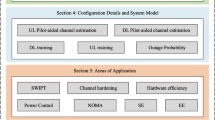Abstract
While demonstrating that partially or completely centralising signal processing at the central processing unit (CPU) improves spectral efficiency, this study advocates for the utilisation of maximum ratio trying to combine at each access point (AP) (SE). Cell-free massive MIMO is indeed a feasible solution for meeting rising user demands and great hopes in post-5G systems. Basic idea is to enable disseminated information access points (APs) to interconnect with all consumers on the system, probably via a single monolithic signal dispensation system. The purpose of the presented paper is for introducing the first thorough assessment of technology at various levels of AP collaborative efforts. The uplink efficiency of four distinct cell-free adoption and implementation is systematically explored using spectral fading and unrestrained linear processing. It did turn out that only by using MRC can it easily exceed both small cell as well as conventional mobile massive MIMO networks. As a result, it is the preferred method for operating CFM-MIMO systems. Nonlinear interpreting research also demonstrates that it makes only a minor difference.
Access this chapter
Tax calculation will be finalised at checkout
Purchases are for personal use only
Similar content being viewed by others
References
Bjornson E, Sanguinetti L (2019) Cell-free versus cellular massive MIMO: what processing is needed for cell-free to win? In: IEEE international workshop signal processing advances in wireless communication (SPAWC)
Vishnuvardhan D, Shaik K, Sai Bhavya P, Yadav P (2018) Monitoring physiological variables of mining workers. NCeTIMES#1.0, IJET ISSN: 2395-1303
Ngo HQ, Ashikhmin A, Yang H, Larsson EG, Marzetta TL (2017) Cell-free massive MIMO versus small cells. IEEE Trans Wireless Commun 16(3):1834–1850
Karimullah S, Vishnu Vardhan D (2022) Pin density technique for congestion estimation and reduction of optimized design during placement and routing. Appl Nanosci
Buzzi S, D’Andrea C (2017) Cell-free massive MIMO: user-centric approach. IEEE Commun Lett 6(6):706–709
Karimullah S, Vishnuvardhan D (2020) Experimental analysis of optimization techniques for placement and routing in ASIC design. In: ICDSMLA 2019, Lecture notes in electrical engineering 601, Springer Nature Singapore Pte Ltd
Aguerri IE, Zaidi A, Caire G, Shamai Shitz S (2019) On the capacity of cloud radio access networks with oblivious relaying. IEEE Trans Inf Theory 65(7):4575–4596
Karimullah S, Vishnu Vardhan D (2020) Iterative analysis of optimization algorithms for placement and routing in ASIC Design. In: ICDSMLA 2019, Lecture notes in electrical engineering 601. Springer Nature Singapore Pte Ltd
Van Chien T, Mollén C, Björnson E (2019) Large-scale-fading decoding in cellular massive MIMO systems with spatially correlated channels. IEEE Trans Commun 67(4):2746–2762
Karimullah S, Vishnu Vardhan D, Javeed Basha S (2020) Floorplanning for placement of modules in VLSI physical design using harmony search technique. In: ICDSMLA 2019, Lecture notes in electrical engineering 601. Springer Nature Singapore Pte Ltd
Aguerri IE, Zaidi A, Caire G, Shamai Shitz S (2019) On the capacity of cloud radio access networks with oblivious relaying. IEEE Trans Inf Theory 65(7):4575–4596
Karimullah S, Vishnuvardhan D (2018) A review paper on optimization of placement and routing techniques. At NC’e-TIMES # 1.0 IN, IJET. ISSN: 2395-1303
Author information
Authors and Affiliations
Corresponding author
Editor information
Editors and Affiliations
Rights and permissions
Copyright information
© 2023 The Author(s), under exclusive license to Springer Nature Singapore Pte Ltd.
About this paper
Cite this paper
Khudsia Tabassum, S., Vishnuvardhan, D., Mamatha, G., Shaik, F. (2023). Making Cell-Free Massive MIMO Using MRC Technique. In: Kumar, A., Ghinea, G., Merugu, S. (eds) Proceedings of the 2nd International Conference on Cognitive and Intelligent Computing. ICCIC 2022. Cognitive Science and Technology. Springer, Singapore. https://doi.org/10.1007/978-981-99-2742-5_1
Download citation
DOI: https://doi.org/10.1007/978-981-99-2742-5_1
Published:
Publisher Name: Springer, Singapore
Print ISBN: 978-981-99-2741-8
Online ISBN: 978-981-99-2742-5
eBook Packages: Computer ScienceComputer Science (R0)




